- Home
- Rabbit Poop
Rabbit Poop
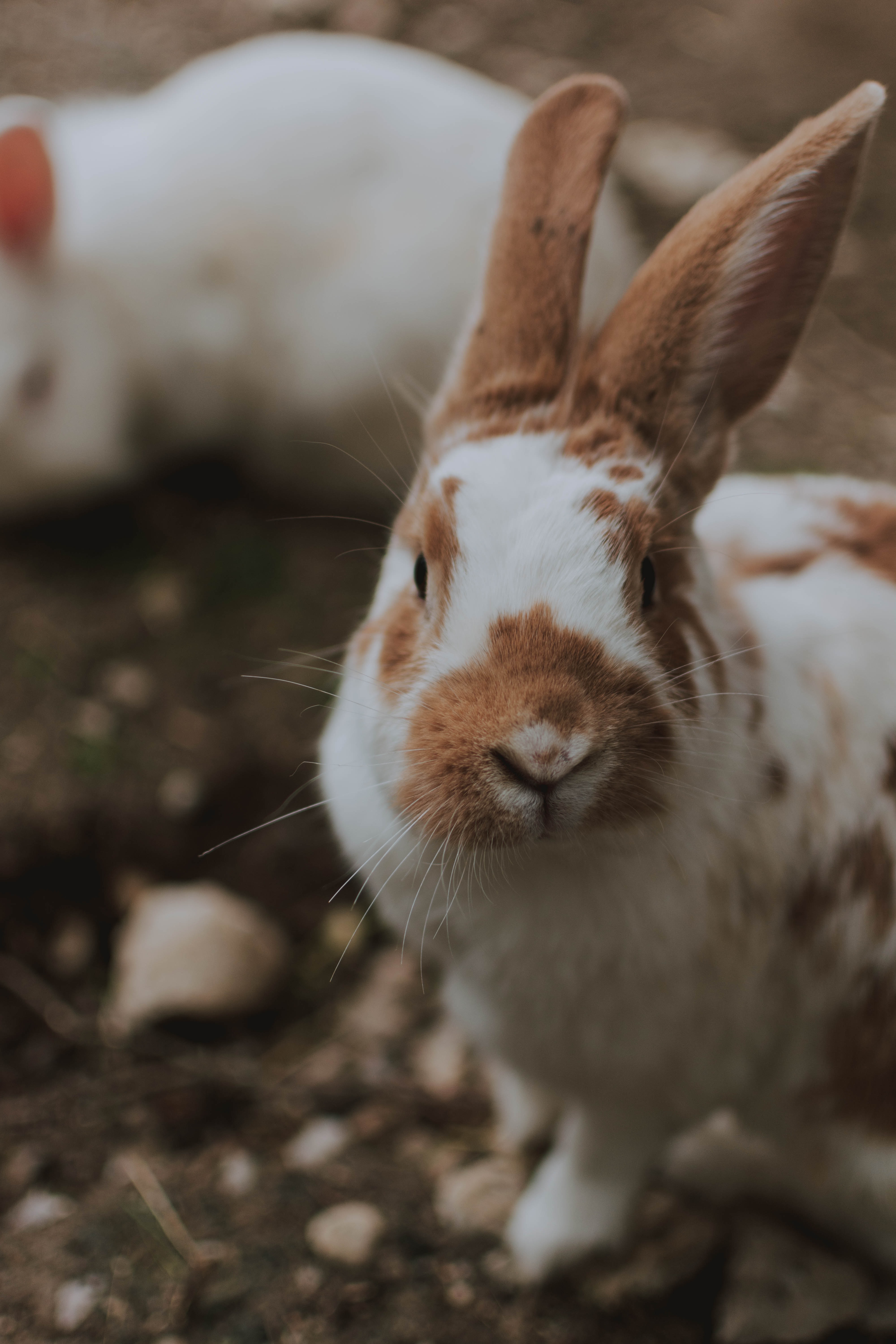 "You people are weird!"
"You people are weird!"Photo by fotografierande on Unsplash.
The Importance of Rabbit Poop
A rabbit's poop can tell you a great deal about the health of that rabbit. That is why owners obsess over the size, quantity and quality of their rabbits' poop. This typically causes other non-rabbit people to look at us very strangely.
A healthy rabbit will produce on average 200-300 hard pellets a day. These hard, round pellets are what you see in the litter box (or maybe the floor). They are dry, odorless and range from light to dark brown in color. You should be able see bits of hay in them and the pellets should crumble easily with some pressure from your fingers.
Rabbits also produce something called cecotropes. Technically, these are not feces as they are not a waste product. Cecotropes are flat, round and dark brown soft poops clustered together into what looks a lot like a blackberry. They are smelly and will squish rather than crumble. Cecotropes are produced in the cecum where billions of bacteria have fermented all of the digestible plant material into a tidy bundle packed full of nutrients. The mucus coat allows rabbits to re-ingest these cecotropes straight from the anus. This is how rabbits get all the nutrients they can from their diets.
Typically, the owner rarely sees cecotropes unless the rabbit produces more than they can consume. This may happen if the rabbit is fed too many pellets, treats or rich greens in his diet or if the rabbit is unable to reach down and consume them (ex. severe arthritis or obesity).
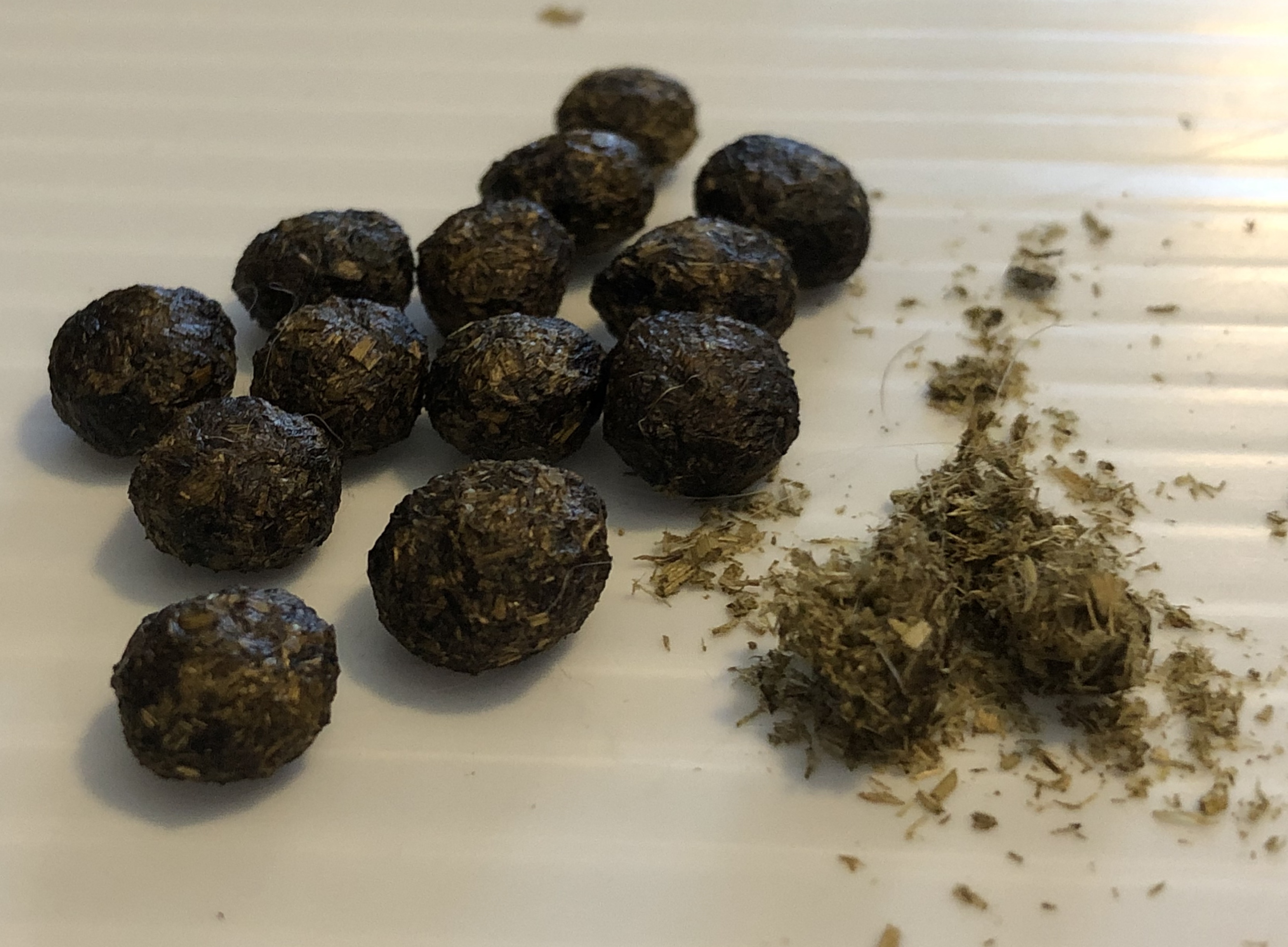 Normal hard pellet poop. It should be dry, break apart easily and you should be able to see bits of hay. Normal hard pellet poop. It should be dry, break apart easily and you should be able to see bits of hay. |
 Normal cecotrope. Much softer than regular poop and should be immediately consumed by the rabbit. Normal cecotrope. Much softer than regular poop and should be immediately consumed by the rabbit. |
Abnormal Rabbit Poop
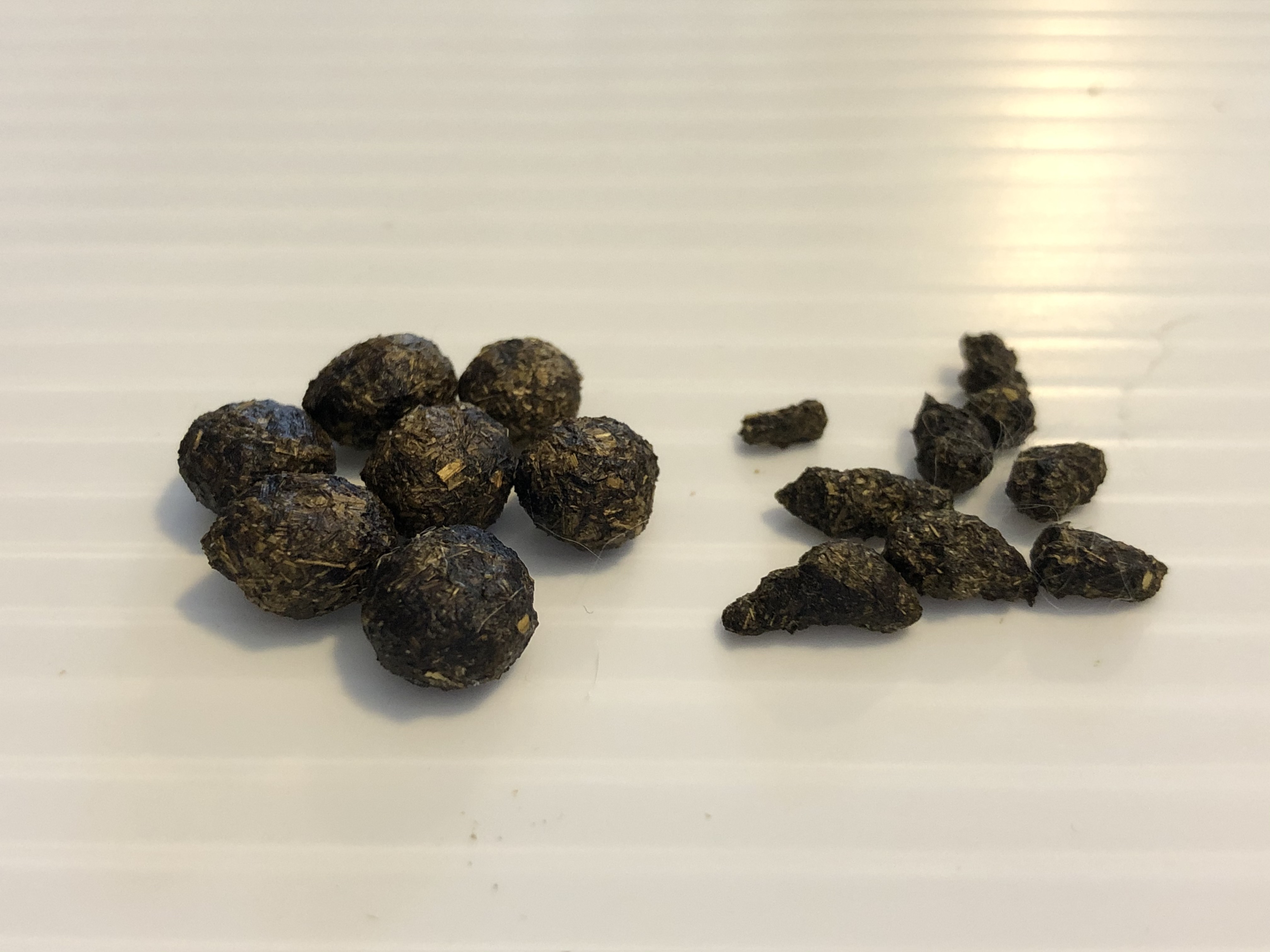 Normal poop (left) and abnormal poop (right).
Normal poop (left) and abnormal poop (right).Abnormal rabbit poop gives you a clue as to what the problem is and how it can be handled. Some problems may indicate an adjustment in the diet while others signal the need for immediate veterinarian help.
Small Misshapen Poop

Small, misshaped rabbit poop indicates dehydration and a lack of fiber. You can increase hydration by offering wet veggies and/or increasing fluids (either syringe-feed extra water or administer sub-cutaneous fluids). Increase fiber by offering more hay and fewer treats and pellets.
There are a couple of situations in which small poop is OK. When a rabbit comes out of stasis, the first poops will be small and misshapen. This is perfectly normal and a good sign, as it means the rabbit is recovering. Within a day or two, his poop will return to normal.
Older rabbits - especially those that have mobility issues - may produce smaller poop. This again is not necessarily a crisis, since the digestive system (along with other internal systems) are slowing down due to age. At this point, the diet for seniors may start to have more calories and less fiber to help keep weight up. Owners definitely need to help keep their bunnies hydrated and still offer plenty of fresh hay. As long as your senior keeps up the amount of poop, he is doing fine.
Strung Together Poop
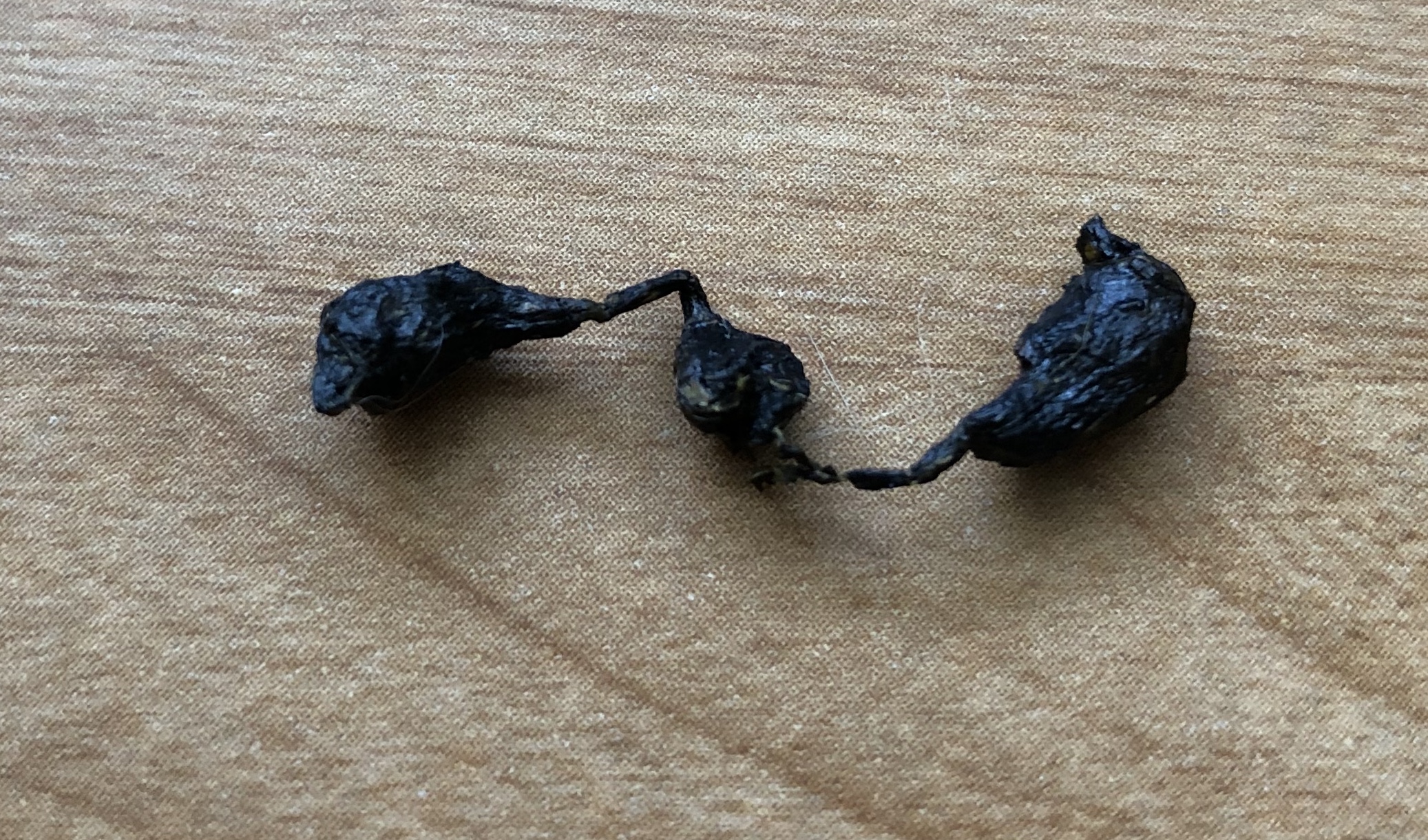
The poop seen here is linked together by fur. The digestive system is working just fine as the fur is being pushed out along with the other fiber. It just might be time to give your bunny a good brushing.
Soft Poop
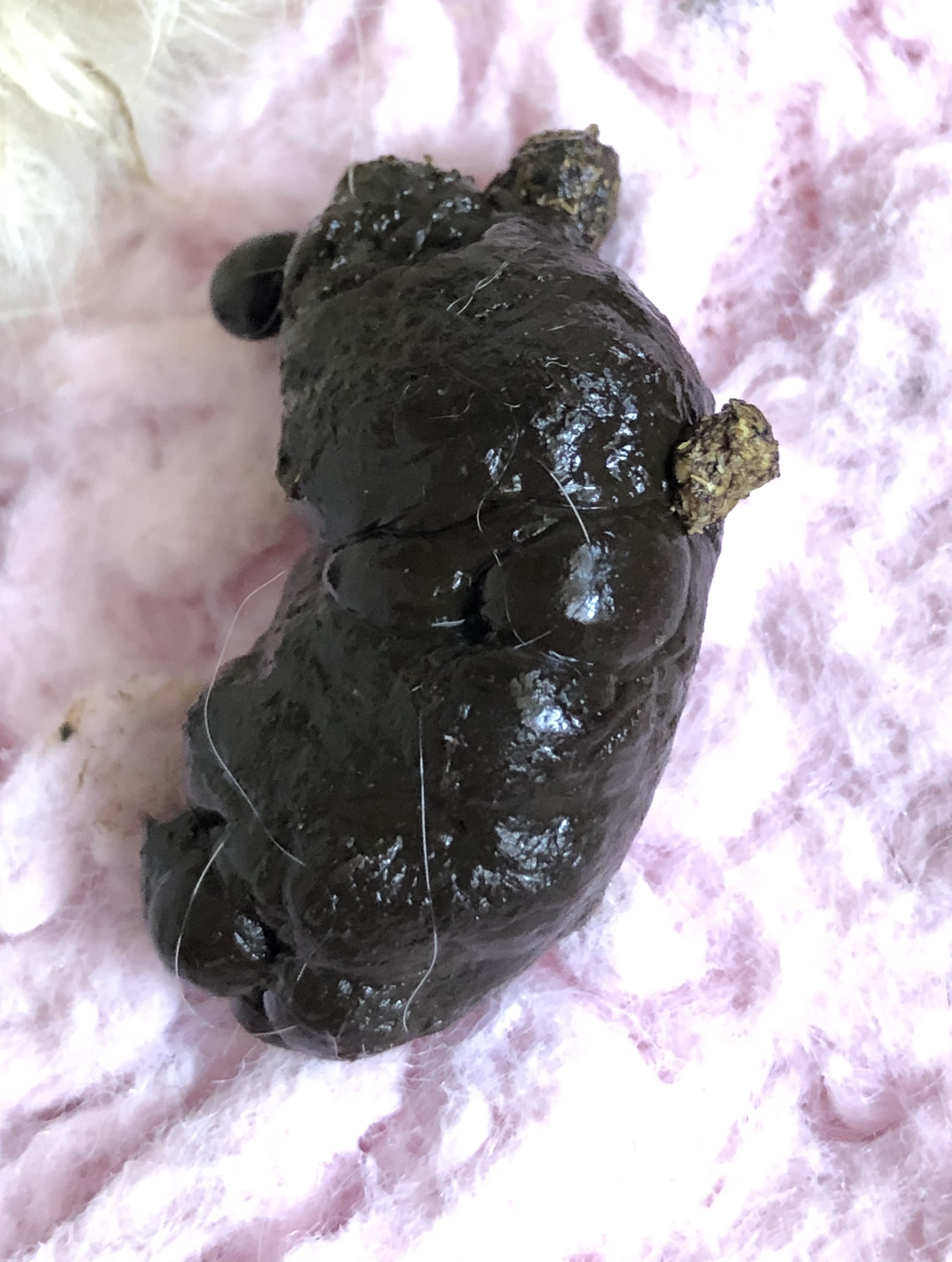 Soft Poop
Soft PoopMost people mistake soft rabbit poop for diarrhea. True diarrhea is quite rare in rabbits, especially healthy adults. You see it more often in young rabbits, particularly those transitioning from weaning. Diarrhea will be very watery.
Soft poop is uneaten cecotropes. It's the result of an imbalance in the diet. Usually, the rabbit has consumed too many treats and/or pellets. Some rich vegetables, such as kale, dandelion greens, carrot tops and chard, may also cause excess cecotropes. If your bunny constantly has a dirty butt, look at the diet. If you feed out kale daily, maybe cut that down to once or twice a week.
Every rabbit is an individual. Certain rabbits may be intolerant of all lettuces or all herbs or all fruit. If you find yourself with a bunny who constantly produces soft poop, you need to eliminate rich vegetables, treats and/or pellets from his diet to help get his gut back into balance. Speak to your vet about how best to re-balance your bunny's digestive system.
Diarrhea
Diarrhea is typically not a huge deal with dogs. When I had to deal with my dog Baci's diarrhea, I would give him plain white rice and dry chicken breast for dinner for a few days. I wouldn't even call my vet unless I suspected one of his five million medications was the culprit.
Diarrhea in rabbits is another matter. It has less to do with raiding the garbage can and more to do with a bacterial or parasitic infection. The poop will look extremely watery. A rabbit with diarrhea needs immediate medical attention.
For a more detailed description on care for young rabbits with diarrhea, click here.
Mucus on Poop
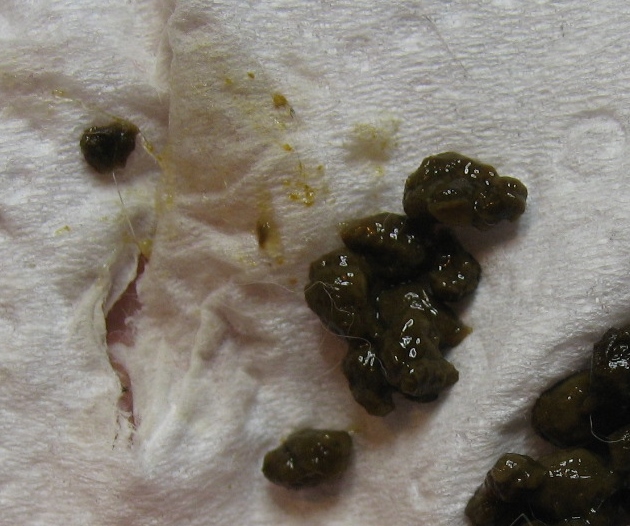 Mucus can be seen on both the poop and paper towel. Photo by Mireya Romo-Bowen.
Mucus can be seen on both the poop and paper towel. Photo by Mireya Romo-Bowen.This will look like a blob of clear jelly on some poop. I have usually seen this in older rabbits, but it can happen at any age. It's the result of irritation in the gut and can be caused by antibiotics, oral pain or anything that may cause slow or intermittent intestinal contractions. It's very common for bunnies when they come out of GI stasis or for older rabbits with chronic dental issues.
Megacolon
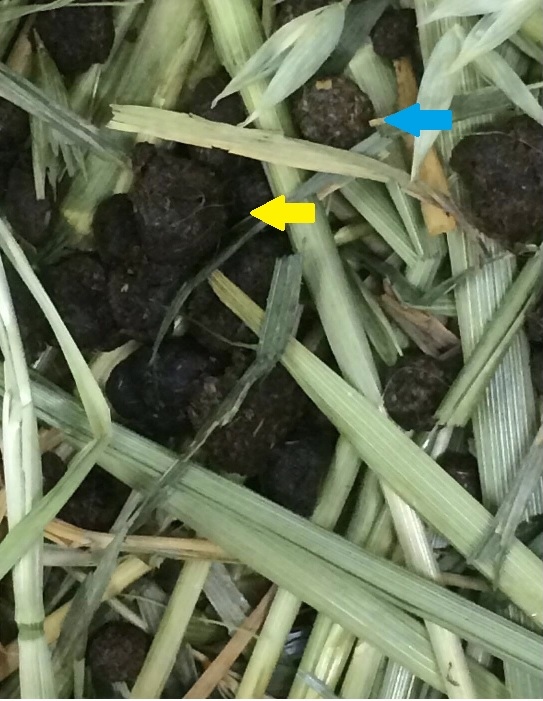 The blue arrow shows a normal sized poop. The yellow arrow shows a megacolon poop. It's large, oval and not as dry.
The blue arrow shows a normal sized poop. The yellow arrow shows a megacolon poop. It's large, oval and not as dry. Photo taken at BunnyLuv Rabbit Resource Center.
Megacolon is a genetic abnormality that affects the intestines, cecum and the nerves controlling muscle contractions in the digestive system. It commonly affects bi or tri-colored spotted rabbits, although it's not breed specific and the condition worsens with age.
Megacolon poops are large oval or oblong in shape and have much more water content than poops from a normal healthy rabbit. This is different from diarrhea. The poops will still retain their shape, but if you squeeze one, water will come out. Cecotropes tend to be long, tarry and almost sausage in shape, with a strong odor.
A megacolon bunny can still have a healthy life, but the owner must be vigilant for any sign of a gut slow down. The bunny may need to be on daily medication for pain relief, prokinetic (gut motility) and fluids (can be oral or via subcutaneous). The diet needs to be tailored specifically to this bunny to ensure proper gut function.
More Images of Rabbit Poop...
Unfortunately, I have not been able to fill my phone with decent pictures of different types of rabbit poop. However, if you are interested in exploring the topic further, check out this informative guide by Christie Taylor, Ph.D.
Dr. Taylor's Ph.D is in biochemistry and molecular biology and she is a long time House Rabbit Society educator and contributor to various journals.
What To Do with So Much Rabbit Poop
Accumulating rabbit poop is good news if you garden. It is rich in nitrogen and phosphorus, but also gentle on plant roots. Other types of manure, such as steer, need to be watered in very well or composted before use. Also, if you have had the misfortune of living next door to someone who uses it twice a year as lawn fertilizer, you know that it smells bad.
Rabbit poop can be used directly in the plant beds or pots, or it can be "brewed," which is a large scoop of poop in a bucket or watering can filled with water. Either method is a great way to feed your garden. Of course, if you are a fan of composting, rabbit poop makes a good addition. For more information on how to compost, click here.
Available Now!
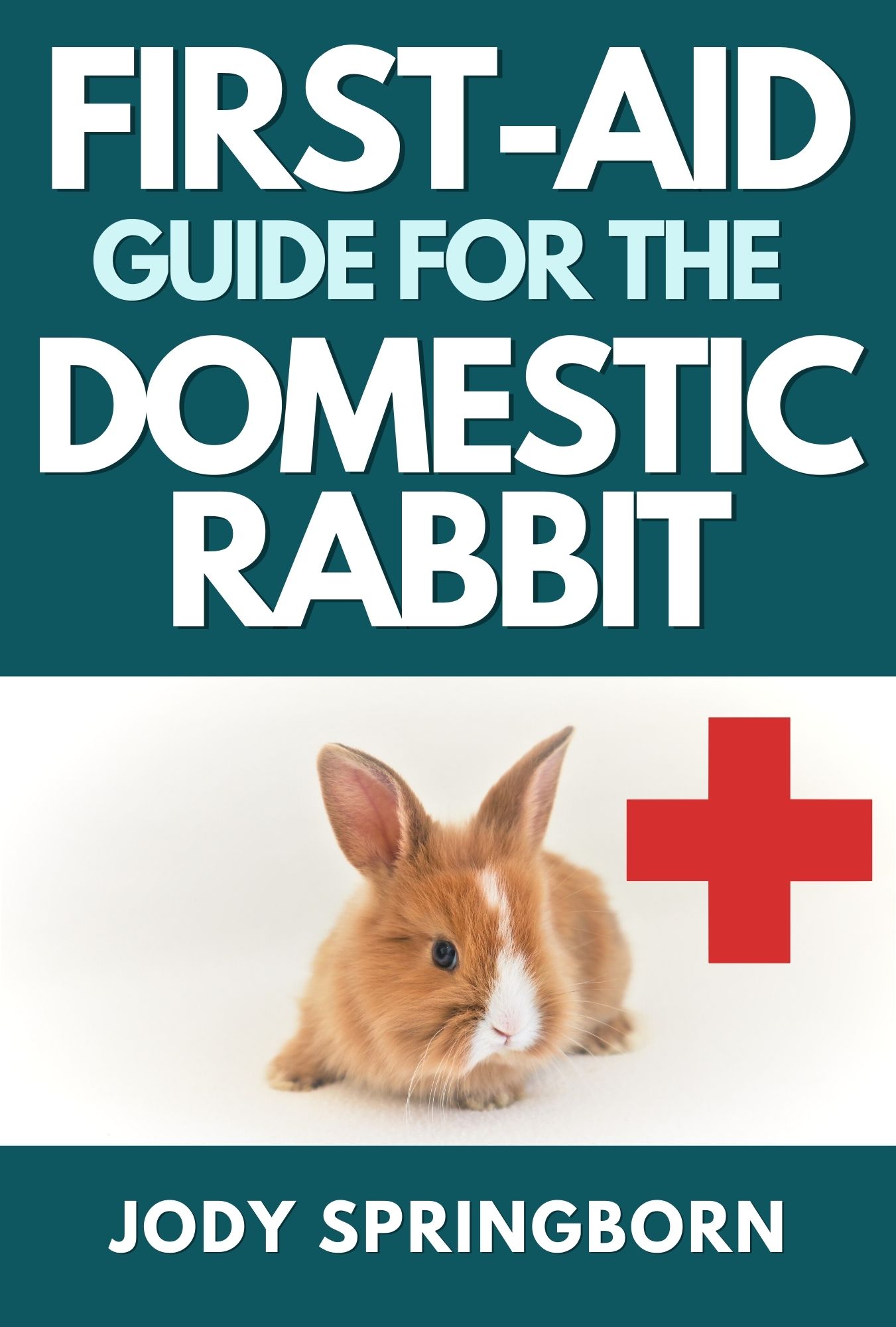
Often times, rabbit health issues require immediate attention. My First Aid Guide for the Domestic Rabbit will show you the most common health issues and teach you the basic skills you should have when your bunny needs you the most. There are over 100 color photos that show you all the supplies you need and how to help your rabbit in easy to follow step-by-step instructions.


